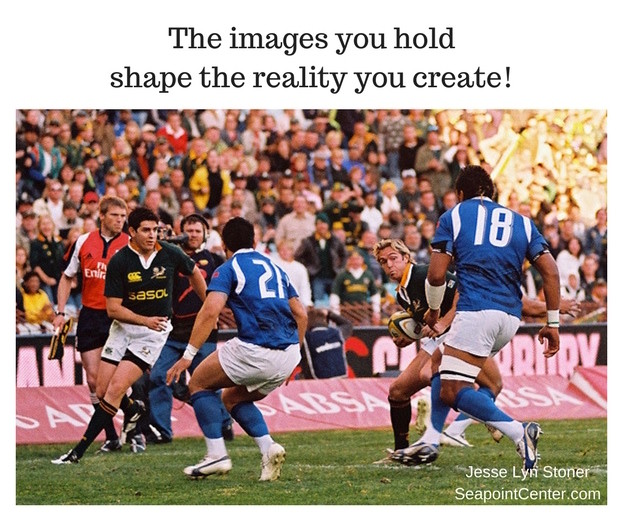
When you expect to see something, you are more likely to notice it. The reticular activating system in our brains causes us to notice the things we expect to see, and not notice things we are not looking for.
And seeing is believing! Literally. Research shows that when we see something, we are likely to believe it.
If your attention is focused on negative images, you’re more likely to see and believe them.
If your attention is focused on positive images, you’re more likely to see and believe them.
What you see shapes the reality you experience.
The problem is it’s not so easy to see positive images. On a daily basis we are bombarded with images of war and destruction in movies, on television and even in electronic games that children play. In contrast, there are few images of what world peace looks like.
And to make matters more difficult, it’s not just that we are bombarded by negative images. Our brains are hard-wired to be attracted to them. Neuropsychologist Rick Hanson explains our brains are Velcro for negativity and Teflon for positivity.
Unless we actively seek out positive images, our sense of reality becomes distorted and unbalanced. Many wonderful and powerful things are happening everyday. But we have to look for them, and we have to be willing to see them.
Leadership and the Power of Positive Images
Nelson Mandela understood the power of creating a unifying positive image. Arrested in 1962 for his role in resistance to South Africa’s apartheid policy of racial segregation, he spent the 27 years in prison. Following his release in1990, Mandela led his party in the negotiations that ended apartheid. In 1994 when he became president, the country was deeply divided, fueled by anger and desire for revenge. By all rights, Mandela himself had every reason to be angry and vengeful. However, he chose a different path.
Holding a vision of a united country, Mandela modeled forgiveness and reconciliation. With the rally call of “one team, one country,” he created an image of what unity could look like – joining the factions to together in support of their rugby team. With national attention and the support of their entire country holding that image, their underdog team, The Springboks, miraculously won the 1995 Rugby World Cup.
7 Things You Can Do Right Now to Create More Positive Images
Although we are bombarded with negative images, we can we seek out positive examples and images to guide us toward a collective future that works for all of us. There are 7 simple things you can do on a daily basis.
1. When you notice something you appreciate, don’t just glance at it. Let your attention linger on it for a full 30 seconds.
2. Don’t participate in the “us vs. them” movement. Refuse to buy into the idea that people with views different from yours are all the same (“them”). Replace divisive images with images of community and connection.
3. As a leader, share the positive examples of what’s going right on your team.
4. Unify your team with a common vision.
5. As a parent or teacher, involve your children in positive efforts that are working to improve your community.
6. Share positive stories with your friends instead of negative ones.
7. Before you go to sleep, think of 3 things that happened during the day that you appreciated, and replay them in your mind.













Even recalling images of the people, your pets, and beautiful places you have been can change your brain’s chemistry. Images rock! Thank you Jesse for great quick tips to start out my day.
Another helpful tip. Thanks, Marcia. We are learning from studies in neuroscience that our brains are pliable and at any age is possible to change its chemistry and rewire neural pathways.
Thanks Jesse. I’m going to practice #7 tonight!
If you do it on a regular basis you can actually rewire your brain to experience more positivity in your life.
Love love love this. No wonder I get down looking at news. So many scowling, pouting faces! I am going to look instead at my beautiful family and friends. Running on my trail and counting the new bunnies and saying good morning to strangers make me smile. Seeing the children last night in adorable Halloween costumes is worth a grin. Only one costume was frightening. Maybe parents are getting the idea that a positive image is the healthiest. Thanks, Jesse
So much of the “news” is not really news – it’s regurgitation of previously reported news or opinions. And 90% of it is negative. We need to protect ourselves from overload. Sweet children in cute costumes is a definite antidote!
There’s actually a great deal of social science research supporting the power of positive images. Most notable, is David Cooperrider’s Positive Image/Positive Action. (https://www.researchgate.net/publication/267403133_Positive_Image_Positive_Action_The_Affirmative_Basis_of_Organizing)
I frequently ask questions that support people to “flip” their negatives. If they complain about something, I’ll ask what it would look like if it were working. Rich, creative conversations that move us to act come out of that.
Appreciate your references and suggestions that extend the ideas in this post, Peggy. And also your comments on Facebook, which I have taken the liberty to paste below for readers of my blog.
Thanks, Jesse – liked this post and the emphasis on looking for points of convergence. Fabricating an “us” against “them” may seem the easy short cut to uniting a team, but at what cost? “Different” does not equal “bad,” and if we close our eyes and ears to other perspectives, we end up losing in the end.
Thanks for posting!
Truth! “if we close our eyes and ears to other perspectives, we end up losing in the end.” Thanks for your insights, Ken!